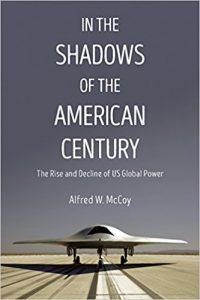 Prior to 2001 and the launch of the War on Terror, the US political elite adamantly denied (despite massive evidence to the contrary), that the United States was an empire rather than a republic. Because their sudden about face (i.e., acknowledgement and promotion of US imperialism) was so recent, there has been little opportunity for scholarly analysis of America’s effectiveness as an empire. It’s this void Alfred McCoy seeks to fill with In the Shadows of the American Century: The Rise and Decline of US Global Power.
Prior to 2001 and the launch of the War on Terror, the US political elite adamantly denied (despite massive evidence to the contrary), that the United States was an empire rather than a republic. Because their sudden about face (i.e., acknowledgement and promotion of US imperialism) was so recent, there has been little opportunity for scholarly analysis of America’s effectiveness as an empire. It’s this void Alfred McCoy seeks to fill with In the Shadows of the American Century: The Rise and Decline of US Global Power.
Competition for Control of the Eurasian Landmass
McCoy traces America’s serious global empire building to their defeat of Spain in the Spanish-American War in 1898, which won them Puerto Rico, Cuba, the Panama Canal Zone and the Philippines. ((In a separate development, the Kingdom of Hawai’i was illegally overthrown by The Committee of Safety (a group of wealthy American/European businessmen) in 1898. The Committee of Safety used U.S. Marines to detain the Queen while they announced their takeover of Hawai’i.)) He maintains that US strategies for empire-building, like those of the former British empire, have mainly relied on seeking and maintaining control of the “World-Island.” The is a term coined by London School of Economics director Halford Mackinder’s World Island in 1904. Under this concept, the World Island consists of the vast European-Asian landmass that is home to 70% of the world’s population, 75% of its global energy resources and 60% of its current productivity.
How the US Maintains Military Control
After the US became the world’s preeminent superpower after World War II, they have used nine basic strategies to maintain military control of the Eurasian landmass: mass surveillance (based on a system of extensive personal data collection that began during their “pacification” ((“Pacification” is a military euphemism for violently subjugating the indigenous population of an occupied country.)) of the Philippines (1898-1907); CIA covert operations (involving electoral interference, military coups, installation of compliant puppet dictators, targeted assassinations, torture, advanced technological weaponry (electronic sensors, satellite imagery, drones, etc) and, increasingly, cyperwarfare and space-based weaponry (most information about the latter two is classified).
Falling Behind China Economically and Militarily
For me the most interesting section of the book examines ways in which the US is rapidly falling behind China — not only economically but militarily. McCoy identifies Bush’s rash decision to invade Iraq as the start of the American empire’s steady decline. While the US has spent the last 16 years mired in unwinnable wars in Afghanistan and Iraq, China is busily building alliances and investing their trade surplus (from selling Americans cheap consumer goods) in Russia and other countries located in the World Island. In Afghanistan alone, they are responsible for 79% of foreign investment.
Meanwhile China is rapidly creating a single economic zone across the Eurasian landmass, with a vast network of high speed trains and pipelines following historical Silk Road and Trans-Siberian Railway routes – and soon a high speed Southeast Asian and Moscow-Beijing line.
Even the Pentagon-linked Rand Corporation predicts China’s will exceed that of the US by 2030 or sooner. In 2010, China became the world’s leading manufacturing nation. In 2014, it took the lead in the number of new patents it awards annually.
Even more concerning is the rapid decline of US educational standards compared to those of China, which has ominous implications for the development of high tech weaponry. Chinese students consistently score first in math, science and reading, while US students score 27th, 20th and 17th respectively.
By 2025, China is expected to have better long range cruise missiles than the US, better air defense aircraft, better electronic sensors, better digital communications capacity, better computer processing power and better cyber-security. At the same time, they have a significant strategic advantage because the US spreads its military resources so thin by fighting so many foreign wars simultaneously.
According to McCoy, they already have the ability to cripple critical US infrastructure (electrical and telecommunications grid and pipelines) via cyber warfare.
Collapse Predicted Between 2030-2040
McCoy predicts (and makes an excellent case for) the demise of the US empire some time between 2030-2040. It could happen gradually, as US economic and military prowess continues its steady decline – or suddenly, if the loss of its privileged status causes the US dollar to collapse. The impending implosion may be aggravated by climate change, especially if the Pentagon is drawn into wars over dwindling food and water resources or control of massive numbers of climate refugees.










